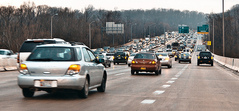Support Maryland’s economy, increase the gas tax

Photo by ehpien on Flickr.
Improving Maryland’s transportation network isn’t just about being “green,” or even moving people and goods. It’s about supporting our regional economy, and a small increase in the gas tax can go a long way.
Earlier this week, University of Maryland Diamondback columnist Andrew Do argued that increasing Maryland’s gas tax would be a “burden” and a “punishment” on drivers. With gas prices nearing $4 a gallon, I’m sure many drivers feel the same way. But what a gas tax can accomplish is well worth it.
Forty years ago, the state of Maryland set up the Transportation Trust Fund, a dedicated funding source for the Maryland Department of Transportation. It gets money from a variety of sources, ranging from the gas tax to car registration fees and transit fares. In recent years, however, it has been depleted not by mismanagement, as Do suggests, but by falling revenues and rising costs.
The gas tax works because you pay for what you use. Those who drive more place more wear and tear on our roads, and they should pay to maintain them. Out-of-state drivers also use our roads, and the gas tax allows them to pay their fair share.
Currently, the gas tax is currently 23.5¢ per gallon, the same as it was in 1992. Meanwhile, construction costs for have doubled. At this rate, the Transportation Trust Fund will run out in 2018. That means no money for transit, no money for roads, and no money to even maintain what we already have.
Even if you don’t use public transit, you reap the benefits of it. Each day, over 700,000 Marylanders take transit, including the Metro, the MTA, and local transit providers like Montgomery County’s Ride On, to work, school and other activities.
Not only do they get an alternative to sitting in traffic, they reduce congestion for everyone else by not driving. A study of our regional transit network’s benefits found that it saves us 148,000 hours a day from being lost to traffic congestion and 40.5 million gallons of fuel each year. If not for transit, we would need to build over 1,000 new lane-miles of highways, the equivalent of adding 15 lanes to the Capital Beltway.
On top of that, every dollar we invest in transit generates $6 in local economic activity. That means more jobs, stronger businesses, and more tax revenue to pay for transportation and other public services. Traffic congestion already burdens our region with wasted time, wasted gas and wasted money. As our state continues to grow, our transportation network needs to grow or it will only get worse.
That means building the Purple Line between Bethesda and New Carrollton, the Baltimore Red Line between Woodlawn and the city, and the Corridor Cities Transitway between Shady Grove and Clarksburg. It means expanding MARC commuter rail so it runs all day, every day. And it means investing in our existing roads and bridges, ensuring that they can handle current and future traffic.
Like many transportation projects around the country, these efforts may get part of their funding from the federal government, but they need to know that Maryland has some skin in the game as well. If we don’t find matching funds for crucial projects like the Purple Line and the Red Line this year when they come up for federal review, they may never get built.
Given, many people in Maryland do drive. Personally, I drive a 2003 Honda Civic, whose gas tank holds about 11 gallons. If our gas tax were raised 14.5¢ a gallon, which would bring it back to where it was in 1992 with inflation, it would cost me $1.59 extra to fill up.
Is that too much to ask? Some, like Andrew Do, might say yes. But it’s a small price to pay for securing Maryland’s economic future. I urge anyone who truly cares about our state’s future to join Get Maryland Moving in the fight for more transportation funding now. You can visit our website, follow us on Facebook and Twitter, and sign our petition calling on Maryland legislators to act now.
